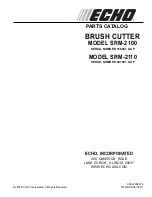
20
SRM-4000/5000
E
N
G
L
I
S
H
D
E
U
T
S
C
H
I
T
A
L
I
A
N
O
RULES FOR SAFE OPERATION
(WITH NYLON LINE CUTTING HEAD)
1. Winkel zur Wand hin
2. Schneidgut
1. Angle to wall
2. Debris
The basic cutting actions pictured are:
Trimming, scything, scalping and lawn edging.
These actions are as follows:
TRIMMING: This is feeding the trimmer carefully into the
material you wish to cut. Tilt the head slightly to direct the
debris away from you. If cutting up to a barrier such as a
fence, wall or tree, approach from an angle where any
debris ricocheting off the barrier will fly away from you.
Move the line head or line disc slowly until the grass is cut
right up to the barrier, but do not jam (overfeed) the line
into the barrier. If trimming up to wire mesh or chain link
fencing, be careful to feed only up to the wire. If you go too
far, the line will snap off around the wire.
Trimming can be done to cut through weed stems one at
a time. Place the nylon line cutter near the bottom of the
weed never high up, which could cause the weed to
chatter and catch the line. Rather than cut the weed right
through, just use the very end of the line to wear through
the stem slowly.
Die hier dargestellten Schneidvorgänge sind wie folgt:
Trimmen, Mähen, Skalpieren und Kantenschneiden.
TRIMMEN: Hierbei wird der Trimmer vorsichtig an das zu
schneidende Material herangeführt. Den Fadenkopf etwas
schrägstellen, damit das Schneidgut von Ihnen weggeleitet
wird. Wenn man auf eine Barriere zuschneidet, wie z.B.
einen Zaun, eine Wand oder einen Baum, müssen Sie sich
in einem Winkel vorarbeiten, so daß von der Barriere
abprallendes Schneidgut von Ihnen weggeleitet wird.
RICHTLINIEN ZUR BETRIEBSSICHERHEIT
(MIT NYLONFADENKOPF)
Bewegen Sie den Nylonfadenkopf oder die Fadenscheibe
langsam, bis das Gras am Hindernis (Baum, Mauer...)
abgemäht ist. Wenn Sie an einem Draht- oder
Kettengliedzaun entlang Trimmarbeiten durchführen,
dürfen Sie den Nylonfaden nicht so weit vorschnellen
lassen, daß er durch Berührung mit dem Zaun reißt.
Beim Trimmen können Unkrauthalme nacheinander
durchgeschnitten werden. Die Nylonfaden-
Schneidvorrichtung unten-nie oben-an der Pflanze
ansetzen, da sich die Pflanze sonst evtl. nur beugt und
dann wieder aufrichtet und sich in dem Nylonfaden
verfangen könnte. Anstatt das Unkraut ganz
durchzuschneiden, führen Sie das Ende des Nylonfadens
allmählich durch den Unkrauthalm.
NORME DI SICUREZZA
(CON TESTINA A FILO DI NYLON)
1. Angolo con il muro
2. Detriti
Le illustrazioni a fianco mostrano le operazioni basilari:
Ripulire i bordi, falciatura, radere al suolo e bordure.
Le azioni pertinenti sono:
RASATURA: È necessario prestare molta attenzione con
il materiale che si desidera tagliare. Scrollate leggermente
il disco per togliere i detriti. Se state per tagliare su una
barriera, come ad esemplo una palizzata, un muro o un
albero, avvicinatevi da un’angolazione tale per cui i detriti
che possono saltare non vi vengano contro.
Muovete la testina di taglio o il disco lentamente finché
l’erba non è stata tagliata fino al punto desiderato, ma non
insistete troppo con il filo perché se andate a cozzare
contro una rete, se il filo è troppo lungo va ad avvolgersi e
ad impigliarsi con la rete.
I bordi si ripuliscono anche falciando un gambo di erbacce
per volta. Mettere l’apparato di taglio con filo di nylon
accanto alla base del fascio, mai in alto dove l’erbaccia
potrebbe vibrare ed impigliarsi nel filo. Anziché falciare
completamente le erbacce, tagliare lentamente il gambo
con la punta del filo.
3. Knife side raised
4. Angle to ground
3. schräggestelltes
Arbeitswerkzeug
4. Winkel zum Boden hin
3. Lato lama alzato
4. Angolo con il suolo
1
2
3
4
















































